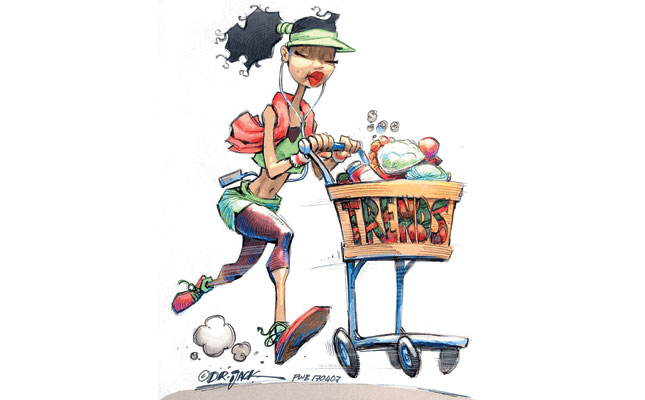
There are many factors that govern a consumer’s food purchasing decisions. The most basic are an individual’s physiological drivers, and specific needs and preferences. There are also external influences such as marketing, religion, culture and health considerations.
Inevitably, people influence each other, leading to trends, which can be defined as similar behaviour and consumption choices amongst large sections of the population.
Small changes in any of the factors that influence consumer behaviour can lead to large-scale consumption trends.
Demographic drivers
It is estimated that the global population will grow 13% by 2030, with Africa accounting for more than half of this growth. Currently, 41% of Africa’s population are children under the age of 15. A similar trend can be seen in South Africa, which has experienced a 37% population growth during the past 20 years.
By implication, this increase means that there is mounting pressure on the agri sector to produce adequate food supplies.
Another demographic driver is the ageing population, with the number of people 60 years and older expected to double by 2050 worldwide. It is expected that 36% of the Japanese population, for example, will be older than 65 by 2040, compared with 23% in 2010.
This group of aging consumers typically focuses on health and longevity.
Other demographic drivers are a rapid increase in urbanisation in both Africa and Asia, and the fact that these urbanites have smaller families.
Locally, Gauteng and the Western Cape have experienced the highest influx of people, with the population in Gauteng growing 9% between 2011 and 2016.
In 2015, about 82% of total household expenditure in South Africa occurred in formal urban areas. Although the number of households has increased, their average size has decreased.
In Gauteng, this figure is below the national average, with only 2,7 people per household. Put another way, households are smaller, but there are more of them.
Single woman households
Another trend driving consumption is that of single woman households. In the US, just over 50% of adults are married, compared with 70% in 1960. The average age of people getting married for the first time in that country is 27, compared with 20 in 1960.
Today, nearly half of all women of child-bearing age are childless and typically spend 35% of their income on groceries.
These demographics are leading to increased demand for healthy, packaged and convenient food products targeted at small or single households, which implies less bulk buying. Yet another demographic driver is the growth of the middle class in developing countries.
In South Africa, the middle income groups (LSM 5 to 7) grew 3,3% between 2011 and 2015, while the proportion of households living in formal dwellings increased 11% since 2001. (Living Standards Measure is a market research tool that segments the population into 10 groups according to income, education and other factors.)
Increased mobility, higher income, and access to information services and education also lead to more informed and healthier food choices.
The final driver is a combination of information networks and technology, with consumers following opinion leaders on social media and making buying decisions accordingly.
Healthy foods and beverages: a major trend
Health and wellness have become a status symbol and increasingly integrated into mainstream food consumption. The number of vegans worldwide has increased by 360% over the past decade, and an analysis of Internet searches shows growing interest in fresh, organic, non-GMO, non-meat and non-dairy products.
Many consumers tend to steer clear of high-fructose corn syrup, GMOs and artificial sweeteners, preferring protein, fibre, whole grains, antioxidants, vitamins, minerals, organic ingredients, natural sweeteners and probiotics.
Plant-based protein is becoming more popular, as are duck meat, shitake mushrooms and whole grains such as quinoa.
Healthy snacks also feature more prominently today. The consumption of popcorn, for example, is predicted to increase more than 40% by 2020. In the UK, popcorn sales have grown more than 169% over the past five years, and it has become one of the fastest-growing snack categories in South Africa.
According to the World Health Organisation, a decline in the manufacture of products containing sugar can be expected, and research into replacements such as stevia leaf, xylitol and extracts of beet sugar are currently underway.
Convenience foods
In our fast-paced society, impatient consumers seek out smaller products that can be eaten on-the-go. UK supermarket chain, Sainsbury’s, recently launched a one-hour food and groceries delivery service by bike.
The demand for house brands is growing locally, with consumers believing that supermarket chains have sourced the best ingredients for these.
The convenience food trend is expected to increase as healthier, better quality convenience foods become available.
The demand for ready-to-drink beverages is also on the increase. Smoothie sales, for example, have grown 166% since 2009. Product innovations in this category include protein drinks, low-calorie energy drinks, reduced-energy iced tea, drinks containing probiotics, vegetable juices, almond milk, coconut water, and aloe water.
Analyses show that consumers search for locally sourced ingredients, while also expressing concern about manufacturers’ practices in terms of social responsibility, environmental sustainability and animal welfare.
Food wastage
Almost a third of food produced on the planet is wasted, and studies indicate that this wastage is responsible for 8% of greenhouse gas emissions. Consumers are directly responsible for 4% of all food losses; the rest occur during farming and production.
Diabetes
Diabetes is a global crisis and the incidence of Type II diabetes is growing in middle- and low-income countries. About 50% of those suffering from the disease remain undiagnosed and unaware.
The main factors contributing to diabetes are poor nutrition due to high-calorie processed food, consumption of food with a high sugar content, and a sedentary lifestyle. Diabetes dramatically increases the risk of various cardiovascular diseases such as heart attack and stroke.
Global health spend on diabetes was more than US$370 billion (about R4,6 trillion) in 2015.
Luxury snacks
Despite the modern focus on healthy living, there is a growing demand for luxury, high-quality snack items, while fast food consumption is growing locally. – Gerhard Uys
The views expressed in our weekly opinion piece do not necessarily reflect those of Farmer’s Weekly.
Email Nadia van der Kolf at [email protected] for further information.










